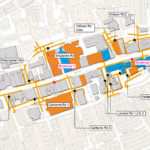Back in January, before the stark realities of the global pandemic hit the UK, the Centre for London authored and published a report: “Building for a New Urban Mobility”. Supported by an advisory group made up of cross-industry leaders, of which I was honoured to have been a part, the report focuses on how an increase in housebuilding is needed to solve London’s housing crisis.
But that how any new (non-central London) development will be required to ‘plug into’ an already-stretched transport system. It examines how technological shifts are reshaping our urban mobility choices and creating opportunities for non-car- dependent lifestyles.
Looking again at the report today – in the context of what we’ve all seen and experienced in the last six months – the issues it covers; the ten principles it outlines; and the eight recommendations it gives to help embed ‘new urban mobility’ in London’s developments, resonate even more strongly now than then at the beginning of 2020.
In the report summary its authors, perhaps presciently, note that ‘new technologies could result in a revolution for active and shared travel, increasing the efficiency of our transport system – but it is also possible that they could worsen London’s congestion, pollution and public realm difficulties by putting more vehicles on the road.”
In some ways, this is exactly the dilemma we are faced with post Covid-19 lockdown and into recovery: an appetite for active travel based on a desire to avoid public transport; opportunities for more efficient public transport networks based on new patterns of working (and indeed living); and more vehicles on the roads as people retreat to the ‘relative safety’ of their private cars to get them from A to B.
There are many, many lessons we – as an industry – can take from the last few months. I’m privileged and honoured to lead a talented team at Momentum which has observed, analysed and written so eloquently on how Covid-19 may have accelerated the urban design and transport trends and options coming through. And how many of these ideas are enablers to tackle the existing challenges we were already facing.
Now more than ever it is incumbent on us all as transport leaders to support development which puts people First. This includes health, safety and wellbeing in this time of international recovery, and beyond, and to respond to those existing, longer-term challenges of climate change, public health and dispossessed communities– to name but a few of the challenges that we are all working on to improve.
Let’s look to transport as an enabler. The glue which joins and keeps communities together. Initiatives such as ’15-minute cities’ in outer London; networks of community routes for use by pedestrians, cyclists, micro-mobility and mobility vehicles; and re-purposing parking spaces, highways and footways
for active travel and for businesses to re-open safely and effectively. We can all see that e-bikes have opened up new and longer commuting journeys for many and these will soon be supported by “e-scooters for hire” that will be permitted on the highway of participating boroughs for the first time.
The recommendations made in the Centre for London’s report are clear: strengthen local political leadership; build adaptability into new developments; unbundle parking spaces from homes; and improve post-completion evaluation. These recommendations are as important now as they were when they were written in January 2020. Perhaps even more so as we look to apply those principles across existing infrastructure as well as for these new challenges.
Anything is possible where there is a will for understanding and an appetite for collaboration and I, for one, relish the chances that have opened up to remove the barriers to active travel – and by doing so to make lasting changes for the good of people and the communities they live in, and for the new communities that we need to build.







